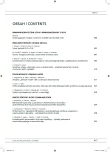Gunshot Wounds of the Head and Brain
Authors:
Marek Sova 1
; M. Duba 1; V. Vybíhal 1
; A. Šprláková 2; L. Juříček 3
Authors‘ workplace:
Neurochirurgická klinika LF MU a FN Brno
1; Radiologická klinika LF MU a FN Brno
2; Univerzita obrany Brno
3
Published in:
Cesk Slov Neurol N 2010; 73/106(5): 547-551
Category:
Short Communication
Overview
Aim:
The authors report the results of treatment to patients with gunshot and captive bolt injury to the brain, all of them undergoing surgery at the Department of Neurosurgery at the Faculty Hospital, Brno in the 2005–2008 period. The article addresses the most important prognostic factors influencing choice of therapeutic procedures. It also includes a classification and pathophysiology of penetrating injuries. The authors present a basic survey of the impact ballistics of gunshot injuries.
Patient group and methods:
The case histories of 20 patients were subjected to operational review. All of them were male, mean age 59, range 33–80 years. Attempts at suicide accounted for 17 of the them; two arose out of negligent handling of a firearm; and one patient was a victim of violent crime. The clinical status of the patients was retrospectively evaluated by means of the Glasgow Outcome Scale [1], 6 months after the penetrating injury on the part of the survivors. The dependence of GOS on the patient’s state of consciousness on admission and the extent of brain involvement according to CT scan were evaluated.
Results:
The patient’s state of consciousness on admission and the extent of brain parenchyma damage on CT scan are the most important prognostic factors dictating approaches to the treatment of these severely injured patients. In our group, the initial Glasgow Coma Scale [2] points totalled 3 in 15 patients (75%), 9 in 1 patient (5%), 14 in 1 patient (5%) and 15 in 3 patients (15%). Initial presenting examination of the brain with computer tomography revealed 9 cases of severe, extensive, multilobar involvement of the brain parenchyma, 11 cases of focal involvement of a single lobe, often in the “eloquent” brain. Mortality in the whole group reached 65%, and 4 cases were classified as donors to the transplantation program.
Conclusion:
The specialist literature indicates that the mortality rate of brain gunshot wounds varies between 60% and 90%, and our group suffered a mortality of 65%. This relatively favourable outcome is determined by the fact that 50% of the wounds were inflicted by a slaughterhouse (captive bolt) gun, which lacks the extended penetration of bullet-firing weapons. Despite the fact that serious primary injury to the brain parenchyma occurs, a favourable prognosis may result from emphasis on minimizing further secondary brain damage.
Key words:
penetrating head injury – gunshot head injury
Sources
1. Jennett B, Bond M. Assessment of outcome after severe brain damage. Lancet 1975; 1(7905): 480.
2. Teasdale G, Jennett B. Assessment of coma and impaired consciousness: a practical scale. Lancet 1974; 2(7872): 81–84.
3. Murray GD, Teasdale G, Braakman R, Cohadon F, Dearden M, Iannotti F et al. The European Brain Injury Consortium survey of head injuries. Acta Neurochir (Wien) 1999; 141(3): 223–236.
4. Navrátil O, Smrčka M, Hanák P. The outcome, working ability and psychic changes after traumatic brain injury. Bratisl Lek Listy 2006; 107(4): 110–112.
5. Smrčka M et al. Poranění mozku. Praha: Grada Publishing 2001.
6. Hirt M, Krajsa J. Krvácení v perivaskulárních prostorech mimo oblast střelného kanálu u poranění mozku. Cesk Slov Neurol N 2005; 68/101(1): 26–28.
7. Hirt M, Krajsa J, Vojtíšek T. Perivascular Brain Microhaemorrhages Accompanying a Penetrating Gunshot Wound of the Chest. Cesk Slov Neurol N 2005; 68/101(2): 116–118.
8. Klein L, Ferko A et al. Principy válečné chirurgie. 1st ed. Praha: Grada Publishing 2005.
9. Komenda J, Juříček L. Ranivá balistika. Brno: Vojenská akademie v Brně 2003.
10. Kneubühl BP et al. Wundballistik – Grundlagen und Anwendungen. 3rd ed. Berlin: Springer Medizin Verlag Heidelberg 2008.
11. Paradot G, Aghakani N, Montpellier D, Parker F, Tadié M. Les plaies crâniocérébrales d’origine balistique – recherche d’arguments pronostiques. Neurochirurgie 2008; 54(2): 79–83.
12. Kim TW, Lee JK, Moon KS, Klak HJ, Joo SP, Kim JH et al. Penetrating gunshot injuries to the brain. J Trauma 2007; 62(6): 1446–1451.
13. Klener J, Zvěřina E, Houšťava L, Haninec P. Střelná poranění hlavy a možnosti neurochirurgické léčby: naše zkušenosti za 10 let. Voj zdrav listy 1993; 57: 197–200.
14. Haninec P, Houstava L, Klener J. Shotgun pellet embolus of the middle cerebral artery treated by emergency embolectomy. Br J Neurosurg 1996; 10(3): 311–314.
Labels
Paediatric neurology Neurosurgery NeurologyArticle was published in
Czech and Slovak Neurology and Neurosurgery

2010 Issue 5
- Metamizole vs. Tramadol in Postoperative Analgesia
- Memantine in Dementia Therapy – Current Findings and Possible Future Applications
- Memantine Eases Daily Life for Patients and Caregivers
- Metamizole at a Glance and in Practice – Effective Non-Opioid Analgesic for All Ages
- Advances in the Treatment of Myasthenia Gravis on the Horizon
Most read in this issue
- Pudendal Neuralgia – a Case Report
- Development of the PLIF and TLIF Techniques
- Cubital Tunnel Syndrome – a Review of Surgical Treatments and Comparison of their Outcomes
- Gunshot Wounds of the Head and Brain
